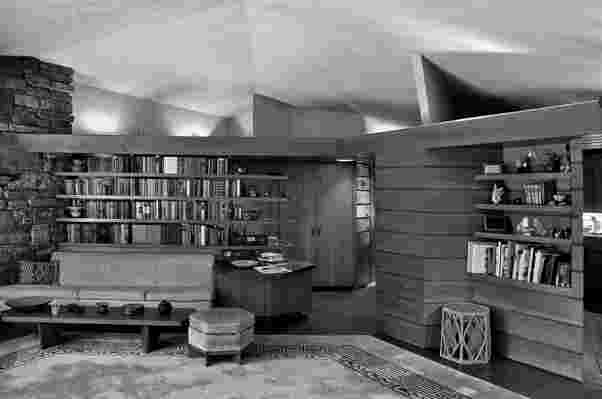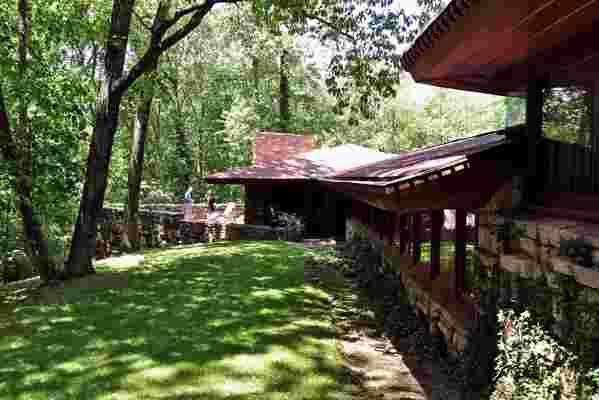This Is the Best-Designed Small Town in the U.S.
In the early 1930s, Frank Lloyd Wright offered up a pared-down vision for the American home: simple, beautiful, affordable, environmentally friendly, and collaboratively maintained. A vision in which no two houses would be alike. That vision came together in Westchester County in the late ’40s, when a group of Wright’s students, including David Henken and Aaron Resnick , set out to create the village of Usonia on 100 acres of wooded land just an hour north of New York City.
Wright—the subject of an upcoming MoMA retrospective celebrating the 150th anniversary of his birth—was an early environmentalist, and the houses of Usonia, heavy in glass and stone with open floor plans, oversized windows, carports, and flat, overhanging roofs, were designed to coexist with the land on which they were built. Today, it’s a perfect gallery of midcentury modern design, a place almost frozen in time. Although some of the 47 original homes were tweaked over the years before a board was established to review all prospective renovations, all retain their original midcentury magnetism.

The living room of a Frank Lloyd Wright house in Usonia.
“Usonia is like a little secret,” says Anneke Leffel of Sotheby’s International Realty, who has sold three Usonia homes over the last decade and is about to put two others, including 6 Usonia Road, on the market. “A lot of people happen to find it by chance, even people who really love midcentury modern design.” Even, she says, prospective buyers who have come to see the Henken-designed home she currently has listed some 25 minutes away in Croton-on-Hudson. For one thing, she says, there’s not a lot of movement; people come and they tend to stay (most notably original owner Roland Reisley, whose house made a recent cameo in a major Hollywood film). When they sell, of course, they tend to do very well. In 2015, a 1958 house designed by architect Aaron Resnick sold for over the $1.149 asking price.
Worth Group editor-in-chief and chief content officer Richard Bradley and his wife happened on Usonia in 2013 after looking at homes along the Hudson. They’d been living in Brooklyn and didn’t know a thing about Usonia. The house they found had been altered over the decades, but plenty of Usonian qualities remained: the central living room built around a fireplace, the red cement floor, the carport. “When we saw the house, we thought—at last,” says Bradley. “We loved the fact that it was nestled in these incredible woods, that it had this very interesting and unusual interior, and that it wasn’t a cookie-cutter house like so many we’d been seeing.”

A home in Usonia.
And Usonia, he says, manages to attract more than just the aesthetically like-minded. “You wouldn’t buy a house here if you didn’t basically buy into the vision of, not just Usonian architecture, but a Usonian community, by which I mean one that is tight-knit and consensus-driven,” says Bradley. One reason is, of course, economic, a belief that home values will increase if everyone is respectful of the Usonian tradition. “But we also value deeply the community aspects of living in Usonia,” he says. “It’s a wonderful place to raise children, and it’s also a wonderful place for anyone with a sense of history. This is not a typical suburban community. It shapes you, just as you can shape it.”